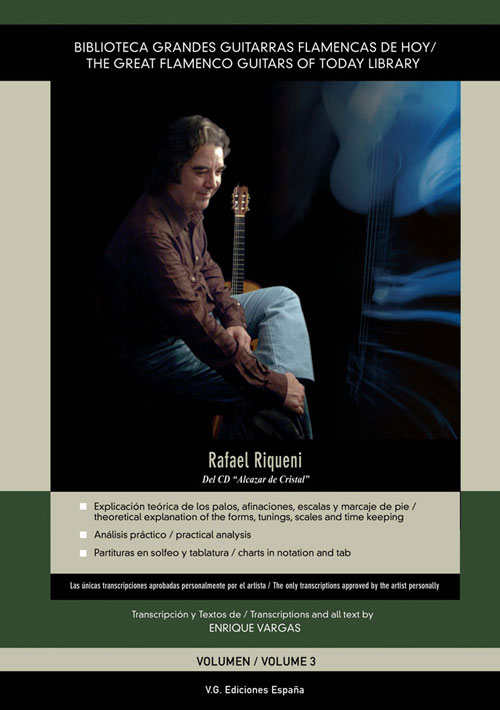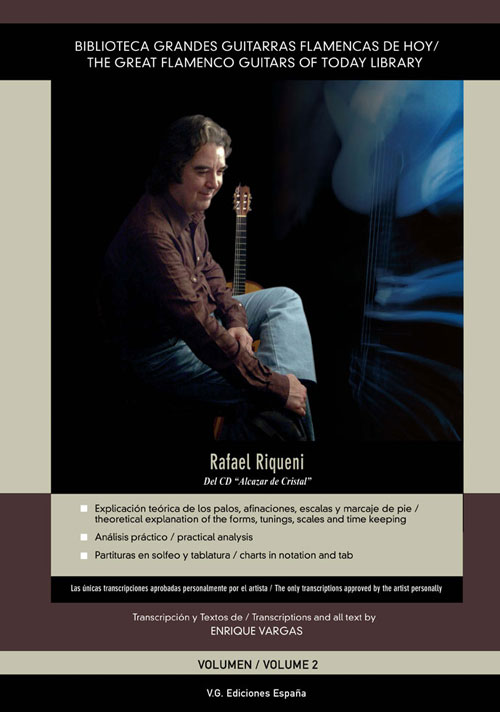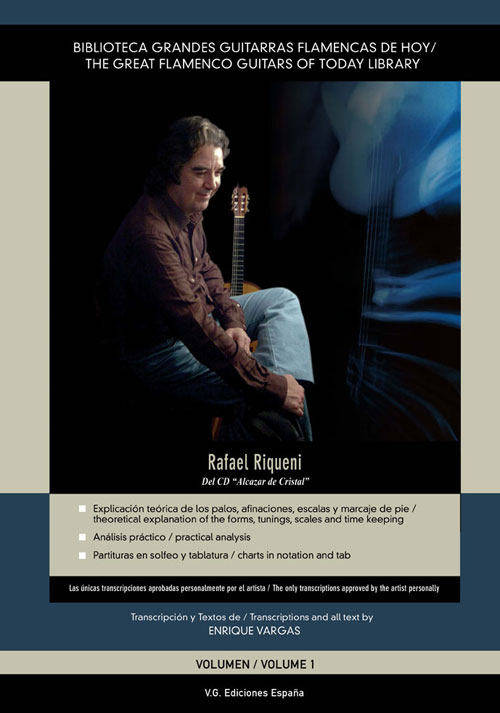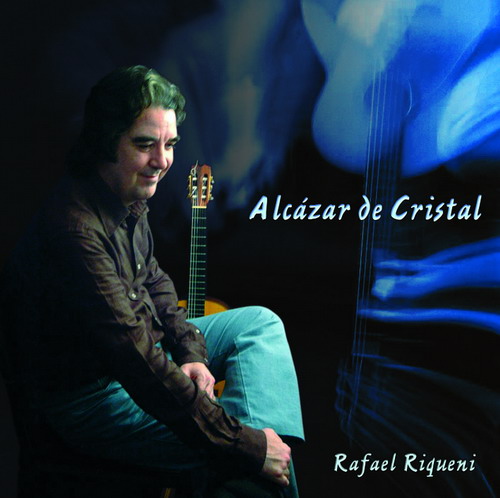- 🚚 📦 WORLDWIDE SHIPPING ✈️ 🌍
Rafael Riqueni Alcazar de cristal CD Score books Vol. 3
The three books of the CD Alcázar de cristal are a new addition to Enrique Vargas's The Great Flamenco Guitarists of Today Library collection.
Son tres volúmenes, aunque se compran individualmente.
''Alcázar de cristal'', the latest work by Rafael Riqueni, is extremely interesting for a variety of reasons:
- First, there is the wide palette of influences found in the work, from baroque to Spanish musical nationalism, and from jazz to nineteenth-century romanticism—all of which Rafael implements within an unmistakably flamenco musical idiom.
- Second, there is the complexity of the arrangements, which sometimes include three guitars, a string section, piano, etc...
Since there is practically no flamenco literature for more than one guitar, great effort has been made to include these arrangements in the transcriptions, which can be used in both professional settings and for didactic purposes. All the parts where there are more than one guitar have been transcribed in their entirety, making these scores ideal for duets or trios. This opens up some very interesting possibilities for professional flamenco groups or for students who prefer to play with another guitarist. For example, musicians who work in dance companies or who accompany singers can use various falsetas from this album that are arranged for more than one guitar. Flamenco guitar students can also interpret these pieces to learn to play with other musicians.
This work includes a series of pieces that don't come from the world of pure flamenco, and therefore don't demand a deep knowledge of flamenco forms and techniques, which makes them accessible to guitarists of other styles—classical, jazz, Brazilian, etc.—interested in the flamenco guitar, making these pieces a sort of link between the flamenco guitar and other genres.
Each transcription includes the following:
1. A history of the form
2. Scales, chords, and flamenco tonalities
3. Compás , palmas and foot-tapping patterns, which, though indispensable for understanding flamenco rhythms, are rarely analyzed in publications about flamenco.
4. Analysis of the most difficult falseta s with explanations and suggestions on their technical execution.
5. A list of basic rasgueados
6. A glossary of flamenco terminology
7. The symbols used in flamenco writing
Score sample
Coments sample
Analisys sample
Since altogether this work is over 600 pages long, it is presented in three books in order to make it possible to use.
This is the habitual format for transcriptions in “ The Great Flamenco Guitarists of Today Library” series: - "Algo que decir" by "el Viejín", - "Alcazar de Cristal" by Rafael Riqueni,, since contemporary flamenco pieces are much longer than they used to be in the past and often include more than one guitar. Enrique Vargas transcribes all the additional guitars, which obviously makes the musical text much longer. In addition, the commentaries, suggestions, and analysis sections make each book a mini-manual of flamenco in general, and the style of each artist in particular.
In this bilingual English/Spanish edition, the sheet music is presented in staff and tablature formats with complete fingerings for both hands.
Volume 3
Edición bilingüe inglés/español.
A4 Format
169 Pages
• “Puente, río, Macarena, Triana”, an impressively eclectic sevillanas whose style, both in the orchestral arrangement and in the arrangement of the two guitars, calls to mind the style of the great Spanish composer Manuel de Falla. It includes a jazz-like improvisational part in which the piano accompaniment has been transcribed for the second guitar.
This piece is a magnificent duet for two flamenco guitars. The “Commentaries” chapter provides an explanation of the structure of sevillanas . The “Analysis” section explains the improvised part, and suggests some scales that can be used during the improvisation. The concept of swing is also explained.
• “Benamargosa”. This fantasy is a magnificent mixture of Spanish impressionism and flamenco. The flamenco part is written to the compás por siguiriya and is explained in the “Analysis” chapter, along with a discussion of the rhythm of this palo and the way to write it according to Stravinsky's system. Enrique Vargas was the first person to write the siguiriya according to this more logical and concise system. The “Commentary and suggestions” chapter provides an explanation of the rondeña tuning used in this piece, along with chords and scales that help to better understand it.
• “Rebelde,” bulerías . This piece is a brilliant solo for flamenco guitar. The “Commentary and suggestions” section provides an extensive study of the evolution of the bulerías rhythm through the twentieth century, various rhythmic patterns for this palo , ways of writing it, and foot-tapping and palmas .
The three books of the CD Alcázar de cristal are a new addition to Enrique Vargas's The Great Flamenco Guitarists of Today Library collection.
Son tres volúmenes, aunque se compran individualmente.
''Alcázar de cristal'', the latest work by Rafael Riqueni, is extremely interesting for a variety of reasons:
- First, there is the wide palette of influences found in the work, from baroque to Spanish musical nationalism, and from jazz to nineteenth-century romanticism—all of which Rafael implements within an unmistakably flamenco musical idiom.
- Second, there is the complexity of the arrangements, which sometimes include three guitars, a string section, piano, etc...
Since there is practically no flamenco literature for more than one guitar, great effort has been made to include these arrangements in the transcriptions, which can be used in both professional settings and for didactic purposes. All the parts where there are more than one guitar have been transcribed in their entirety, making these scores ideal for duets or trios. This opens up some very interesting possibilities for professional flamenco groups or for students who prefer to play with another guitarist. For example, musicians who work in dance companies or who accompany singers can use various falsetas from this album that are arranged for more than one guitar. Flamenco guitar students can also interpret these pieces to learn to play with other musicians.
This work includes a series of pieces that don't come from the world of pure flamenco, and therefore don't demand a deep knowledge of flamenco forms and techniques, which makes them accessible to guitarists of other styles—classical, jazz, Brazilian, etc.—interested in the flamenco guitar, making these pieces a sort of link between the flamenco guitar and other genres.
Each transcription includes the following:
1. A history of the form
2. Scales, chords, and flamenco tonalities
3. Compás , palmas and foot-tapping patterns, which, though indispensable for understanding flamenco rhythms, are rarely analyzed in publications about flamenco.
4. Analysis of the most difficult falseta s with explanations and suggestions on their technical execution.
5. A list of basic rasgueados
6. A glossary of flamenco terminology
7. The symbols used in flamenco writing
Score sample
Coments sample
Analisys sample
Since altogether this work is over 600 pages long, it is presented in three books in order to make it possible to use.
This is the habitual format for transcriptions in “ The Great Flamenco Guitarists of Today Library” series: - "Algo que decir" by "el Viejín", - "Alcazar de Cristal" by Rafael Riqueni,, since contemporary flamenco pieces are much longer than they used to be in the past and often include more than one guitar. Enrique Vargas transcribes all the additional guitars, which obviously makes the musical text much longer. In addition, the commentaries, suggestions, and analysis sections make each book a mini-manual of flamenco in general, and the style of each artist in particular.
In this bilingual English/Spanish edition, the sheet music is presented in staff and tablature formats with complete fingerings for both hands.
Volume 3
Edición bilingüe inglés/español.
A4 Format
169 Pages
• “Puente, río, Macarena, Triana”, an impressively eclectic sevillanas whose style, both in the orchestral arrangement and in the arrangement of the two guitars, calls to mind the style of the great Spanish composer Manuel de Falla. It includes a jazz-like improvisational part in which the piano accompaniment has been transcribed for the second guitar.
This piece is a magnificent duet for two flamenco guitars. The “Commentaries” chapter provides an explanation of the structure of sevillanas . The “Analysis” section explains the improvised part, and suggests some scales that can be used during the improvisation. The concept of swing is also explained.
• “Benamargosa”. This fantasy is a magnificent mixture of Spanish impressionism and flamenco. The flamenco part is written to the compás por siguiriya and is explained in the “Analysis” chapter, along with a discussion of the rhythm of this palo and the way to write it according to Stravinsky's system. Enrique Vargas was the first person to write the siguiriya according to this more logical and concise system. The “Commentary and suggestions” chapter provides an explanation of the rondeña tuning used in this piece, along with chords and scales that help to better understand it.
• “Rebelde,” bulerías . This piece is a brilliant solo for flamenco guitar. The “Commentary and suggestions” section provides an extensive study of the evolution of the bulerías rhythm through the twentieth century, various rhythmic patterns for this palo , ways of writing it, and foot-tapping and palmas .

















